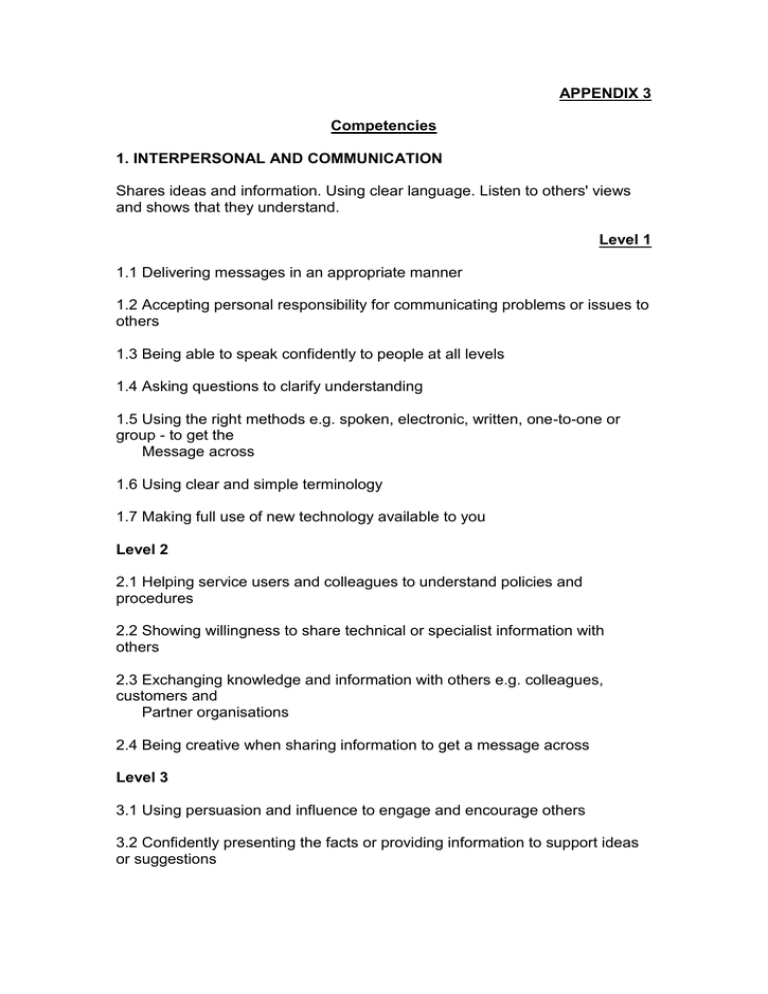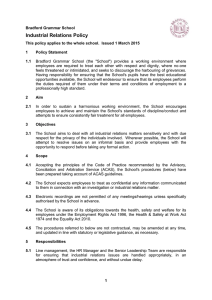APPENDIX 3 Competencies 1. INTERPERSONAL AND COMMUNICATION
advertisement

APPENDIX 3 Competencies 1. INTERPERSONAL AND COMMUNICATION Shares ideas and information. Using clear language. Listen to others' views and shows that they understand. Level 1 1.1 Delivering messages in an appropriate manner 1.2 Accepting personal responsibility for communicating problems or issues to others 1.3 Being able to speak confidently to people at all levels 1.4 Asking questions to clarify understanding 1.5 Using the right methods e.g. spoken, electronic, written, one-to-one or group - to get the Message across 1.6 Using clear and simple terminology 1.7 Making full use of new technology available to you Level 2 2.1 Helping service users and colleagues to understand policies and procedures 2.2 Showing willingness to share technical or specialist information with others 2.3 Exchanging knowledge and information with others e.g. colleagues, customers and Partner organisations 2.4 Being creative when sharing information to get a message across Level 3 3.1 Using persuasion and influence to engage and encourage others 3.2 Confidently presenting the facts or providing information to support ideas or suggestions 3.3 Explaining tasks succinctly and clearly so intended outcomes are achieved 3.4 Walking the job' and encouraging informal exchanges with employees 3.5 Facilitating 'top down, bottom up' communication 3.6 Delivering and receiving appropriate feedback Level 4 4.1 Using a variety of influencing strategies 4.2 Encouraging a climate of openness 4.3 Using the right media and communication styles to suit the audience and the occasion 4.4 Setting up internal and external communication systems to convey information from the Council 4.5 Bringing people on board with ideas and initiatives 4.6 Ensuring that language and behaviour in the service is respectful to everyone 2. CUSTOMER FOCUS Finds out what the customer needs and responds willingly. Makes sure that the services the Council offers meet the needs of the customers Level 1 1.1 Being polite and sympathetic, even when needs cannot be met 1.2 Identifying the needs of the customer 1.3 Demonstrating willingness to 'go the extra mile' to satisfy customer's needs 1.4 Accepting ownership of service requests 1.5 Stating clearly to the customer what Salford can and cannot provide 1.6 Responding professionally 1.7 Viewing complaints as an opportunity to improve performance Level 2 Promoting the service 2.1 Building an effective relationship with the customer 2.2 Capturing customer feedback and building this into service planning 2.3 Ensuring that project designs embrace the needs and concerns of all the customers 2.4 Adapting the service to meet customer needs and priorities 2.5 Consulting with community groups and other agencies in the development of services Level 3 3.1 Consulting customers on levels of satisfaction and quality of service 3.2 Monitoring customer demand 3.3 Planning ahead to cover peaks and troughs in services 3.4 Ensuring service charter markers are met 3.5 Consulting with customers and identify where there is a need for new services 3.6 Identifying non-service users and address why this is the case 3.7 Making innovative use of quality systems and user involvement models to continually Improve service performance 3.8 Planning and introducing suitable training to ensure high level of customer Responsiveness 3.9 Introducing improvement to services in response to customer feedback 3.10 Having a full knowledge of how to promote equalities and ensures compliance with these principles within the service Level 4 4.1 Ensuring all change and re-organisation is driven by customer need 4.2 Ensuring that needs of the customer are reflected on all service delivery plans e.g. Business plans, Community Strategy 4.3 Committing to community cohesion 4.4 Encouraging joined-up services by working with Salford Strategic Partnerships 3. EQUALITY AND RESPECT Shows respect for others' differences and looks for the chance to promote equality of opportunity and good relations within the community. Level 1 1.1 Responding to customers needs on an individual basis 1.2 Delivering services which take account of different cultures and customs 1.3 Integrating the need for equality and respect for others into everyday work 1.4 Taking steps to provide an inclusive workplace 1.5 Changing behaviour and language style to meet the needs of the individual 1.5 Helping customers to access services 1.6 Challenging discrimination, prejudice and unethical behaviour 4. LEARNING AND DEVELOPMENT Takes personal responsibility for their own learning and professional improvement. Sees when they need to learn new skills and looks for opportunities to practice them. Helps others by sharing skills, giving regular, honest and useful feedback. Level 1 1.1 Ensuring they have knowledge and experience of all areas of their work 1.2 Encouraging from others to improve performance and act on the information given 1.3 Taking personal action to improve and develop professionally 1.4 Taking the initiative and develop new ways of working based on learning 1.5 Sharing knowledge and experience with others 1.6 Keeping up-to-date on good practice and council policies Level 2 2.1 Identifying and agreeing development needs and opportunities for staff 2.2 Creating a learning culture 2.3 Identifying and developing talented people to meet succession plans 2.4 Making themselves available and approachable to act as a coach, providing guidance and support when wanted 2.5 Providing constructive feedback 2.6 Encouraging others to assess their own capability 2.7 Keeping up-to-date with development and research in your own field modelling good practice. 5. LEADERSHIP Open and ethical. Sets high standards of behaviour, inspiring and promotes a culture that supports continuous improvement commitment, enthusiasm and facilitates change Level 1 1.1 Identifying any actions needed to move an initiative forward and communicating that to their manager 1.2 Supporting team leaders and managers 1.3 Encouraging others and acknowledging their achievements 1.4 Gaining the trust, support and respect of colleagues 1.5 Offering productive feedback, where appropriate 1.6 Adhering to 'best practice' and carry out your work in a professional and ethical manner 1.7 Taking personal responsibility to resolve issues Level 2 2.1 Providing cover for the line manager in their absence 2.2 Co-ordinating projects and meeting required targets 2.3 Creating buy-in and commitment to projects by being convincing and persuasive 2.4 Being an ambassador for the service when dealing with internal and external contacts 2.5 Projecting self confidence in your capabilities, knowledge and experience Level 3 3.1 Encouraging active participation and positive contributions to the team 3.2 Providing clear direction to the team that is in line with the Councils core purpose and values 3.3 Showing appreciation for individual & team contributions 3.4 Delegating and trusting others to do a good job 3.5 Being assertive and taking a firm stance, when appropriate 3.6 Providing guidance and support 3.7 Actively listening and responding to suggestions 3.8 Addressing and resolving issues surrounding under-performers 3.9 Removing any de-motivating factors 3.10 Ensuring equal access to training and promotion opportunities Level 4 4.1 Getting things done through developing and upholding an effective network of business contacts 4.2 Providing clear vision, direction and purpose for the service 4.3 Communicating Council objectives and explaining how teams and individuals contribute to achieving these goals 4.4 Being a visible presence throughout the Council 4.5 Gaining the confidence and buy-in of other senior managers, members and partners 4.6 Empowering team leaders and managers 4.7 Seeking feedback on your leadership style and acting on it 4.8 Ensuring that knowledge of past successes and failures are incorporated into any new decisions or actions 4.9 Ensuring that recruitment and promotion are open to all, using fair and objective means to discriminate based on job competence 4.10 Modelling respect for and value of a diverse organisation and community 4.11 Taking final responsibility for poor service levels and ensuring corrective action is in place 6. MANAGING PEOPLE Ensures staff are well trained, knowledgeable, motivated and committed. Seeks to release the full potential of all employees. Level 1 1.1 Assesses current and future staffing needs 1.2 Uses a range of selection processes to secure the best candidate. 1.3 Provides appropriate opportunities for new starters to achieve the competence required to carry out role effectively. 1.4 Encourages the team to support new team members. 1.5 Is competent at interviewing. 1.6 Uses probationary system positively. 1.7 Values diversity and seeks to create a diverse workforce 1.8 Is reactive to staffing requirements Level 2 2.1 Manages occupational health and safety issues in the workplace. 2.2 Takes action to manage and monitor stress within the workplace. 2.3 Takes action promptly where there are potential risks to health and well being. 2.4 Actively encourages staff to maintain a balance between work and home life 2.5 Monitors attendance for indications of needs for support 2.6 Creates a culture where staff feel able to question and challenge the status quo Level 3 3.1 Continuously looks at how to get the best out of people 3.2 Takes responsibility for developing self 3.3 Uses a variety of methods to encourage new learning 3.4 Encourages coaching /mentoring 3.5 Recognises talent and rewards 3.6 Encourages innovation creativity and continuous improvement 3.7 Recognises the benefits of staff development Level 4 4.1 Leads by example and has a positive attitude. 4.2 Provides staff with a clear sense of: direction. 4.3 Supports staff appropriately through change 7. MANAGING RESOURCES Plans and uses physical resources effectively and efficiently according to need by prioritising and using sound management practice. Level 1 1.1 Operates in a responsible manner. 1.2 Uses the concepts of Economy, Efficiency & Effectiveness in all aspects of business. 1.3 Applies risk management principles to all aspects of resource decisions 1.4 Uses appropriate methods of I' managing and controlling resources' (people, assets and consumables). 1.5 Knows how to carry out financial ' planning effectively. 1.6 Understands service planning and operations planning. 1.7 Promotes the meaning and principles of best value & knows what "adds value" Level 2 2.1 Identifies where performance could be improved and takes appropriate action. 2.2 Fosters an environment for innovation and creativity where failure is viewed as a learning opportunity. 2.3 Supports staff to continuously improve service and quality. 2.4 Reviews services with the e- government agenda in mind. 2.5 Actively engages in timely statistical analysis for national and local best value performance indicators. 2.6 Uses performance information to improve service delivery. 2.7 Gives high priority to performance management allocating adequate staffing resources to engage in service review effectively 8. THINKING AND TAKING DECISIONS Is forward looking, innovative and has a clear vision. Makes and transmits decisions in a structured and systematic way and encourages wide spread input and ownership. Level 1 1.1 Bringing unresolved or persistent issues to the attention of managers or supervisors 1.2 Taking responsibility for finding a solution with minimum distribution to customers 1.3 Learning from past experience and applying this to new or current problems 1.4 Being able to consider several different solutions and evaluate the effectiveness of each 1.5 Identifying connections or patterns of problems Level 2 2.1 Analysing and understanding complex data 2.2 Using specialist knowledge of customers and services to introduce solutions 2.3 Seeing the connection between seemingly unrelated pieces of information 2.4 Making timely decisions under pressure 2.5 Being resourceful, looking for alternatives when faced with obstacles Level 3 3.1 Identifying urgent decisions, taking prompt decisive action when needed 3.2 Following a logical and reasoned approach when committing to a course of action 3.3 Analysing and absorbing information quickly 3.4 Making tough or unpopular decisions when required 3.5 Identifying problems and making decisions under pressure Level 4 4.1 Making strategic decisions taking into account cross-service functions 4.2 Considering the broader impact of actions and decisions on the city. 4.3 Continuously searching for better ways of doing things that impact on operational improvements 4.4 Creating an environment where people can problem solve creatively and quickly 4.5 Making major decisions when faced with complex and ambiguous situations 4.6 Reinforcing the promotion of equalities and ensure that the principles are reflected in all decision making and initiatives. 9. DEVELOPING STRATEGY, PLANNING AND ORGANISING Ensures team is able to deliver its objectives. Effectively contributes to formulation, development, transmission and review of strategy and policy. Level 1 1.1 Prioritising your own work effectively, and be aware of other people's priorities 1.2 Arriving at meetings and appointments on time, with the necessary paperwork and information 1.3 Taking a proactive approach to work, to avoid 'fire-fighting' 1.4 Suggesting improvements on how work can be better organised to reach objectives 1.5 Responding flexibly to changing demands and priorities 1.6 Working with minimum supervision 1.7 Managing their workload in order to complete tasks on time and to specification Level 2 2.1 Effectively using existing systems and technology for personal and project organisation, For example weekly planners, Microsoft Outlook, etc. 2.2 Managing their workload in order to complete projects on time and to specification 2.3 Monitoring progress against project plans 2.4 Identifying a logical series of steps to accomplish goals 2.5 Using systems to ensure resources are managed officially and cost effectively 2.6 Including the promotion of equality and diversity in projects and plans Level 3 3.1 Planning and organising the work of the team 3.2 Delegating effectively 3.3 Setting and agreeing specific, measurable, achievable, realistic objectives 3.4 Encouraging team members to organise themselves by setting a good example modelling best practice 3.5 Assessing risk and setting contingency plans 3.6 Translating strategy into workable service goals and objectives 3.7 Monitoring technological, operational and financial resources 3.8 Understanding the importance of and implement Race Equality Plans Level 4 4.1 Setting strategic objectives for the service 4.2 Producing a business plan to corporate standards 4.3 Monitoring achievement of objectives as set out in the business plan 4.4 Making strategic plans to meet equality and diversity targets that deliver positive changes. 4.5 Aligning human, physical and financial resources to strategic planning 4.6 Developing and maintaining an awareness of the organisation, its politics and goals 4.7 Integrating clear actions on equalities into business plans to set up positive changes

